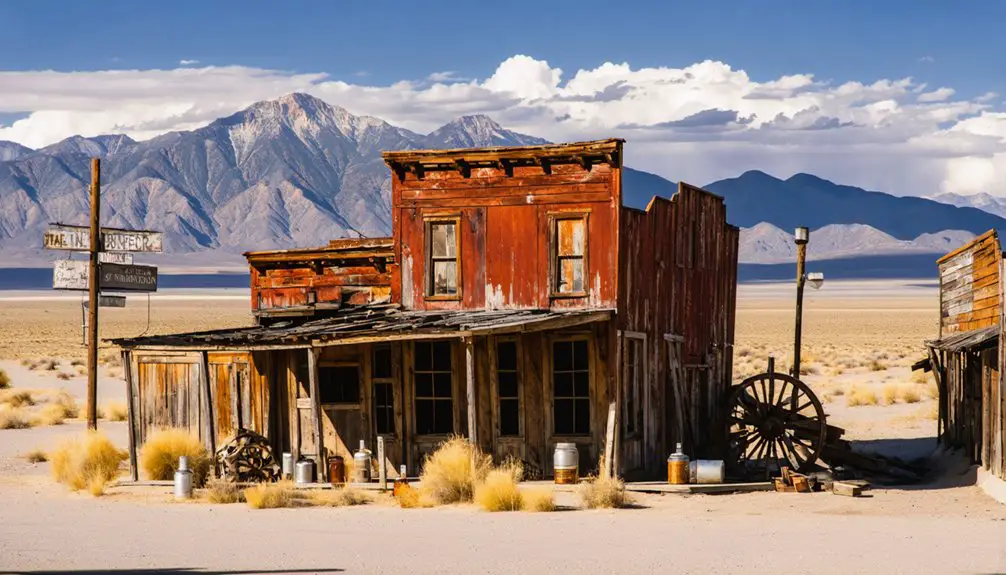You’ll find Palmetto, Nevada’s stone ruins standing as testimony to multiple silver mining booms between 1866 and the 1920s. The site’s most significant period occurred from 1903-1906, when over 200 canvas tents housed miners along a bustling commercial street. While flash floods have destroyed portions of this ghost town, you can still explore the original 1866 twelve-stamp mill foundations and other structures that reveal fascinating details about Nevada’s volatile mining history.
Key Takeaways
- Palmetto is a Nevada ghost town established in 1866 after silver ore discovery, named for Joshua trees mistaken as palmetto trees.
- The town experienced four population waves, with its largest boom during 1903-1906 when over 200 tents housed miners and businesses.
- A 12-stamp mill processed silver ore, generating approximately $6.5 million before declining yields led to the town’s abandonment.
- The settlement featured a tent city with a half-mile commercial street, weekly newspaper, and postal services during peak operations.
- Today, stone ruins and mill foundations remain as a Nevada Historical Landmark, preserving evidence of early mining operations.
The Birth of a Silver Mining Camp
When three prospectors discovered silver ore in 1866 at the south end of Nevada’s Silver Peak Range, they established what would become the mining camp of Palmetto. T.W. McNutt, H.W. Bunyard, and Thomas Israel’s prospector stories led to swift development of the site, where they’d organize a formal mining district that same year.
You’ll find it fascinating that the camp’s name stems from these prospectors’ misidentification of local Joshua trees, which they believed were similar to palmetto trees from their native South Carolina.
Their mining techniques quickly evolved from basic prospecting to industrial operations, as evidenced by the installation of a 12-stamp mill before year’s end. By 1868, the New York and Silver Peak Mining Company had expanded operations, bringing in another 12-stamp mill and employing up to 60 workers. The discovery of the Windypah section in 1903 by J.G. Fesler sparked a third revival of mining activity in the area. Unfortunately, the initial silver vein that sparked such excitement played out in two months, leading many miners to abandon their claims.
Boom and Bust: Population Waves
You’ll find Palmetto’s population history marked by four distinct waves of migration, with the most dramatic surge occurring between 1903-1906 when over 200 tents transformed the landscape into a bustling commercial center.
Each population wave directly corresponded to cycles of mining activity, from the initial 1866 silver discovery through the final 1920s revival. Like many places sharing the name, this Nevada settlement required careful place name disambiguation to distinguish it from other Palmetto locations across America.
The tent city’s fleeting existence during the 1906 peak, complete with its mile-long commercial district, exemplifies the temporary nature of these mining-driven settlements. Similar to other ghost towns in Esmeralda County, the area experienced significant population fluctuations tied to economic factors and mining booms.
Major Population Surges
Throughout its brief existence, Palmetto experienced four distinct population surges, each driven by renewed mining prospects and subsequent disappointments.
You’ll find the first surge in 1866 introduced mining technology like a 12-stamp mill, though insufficient ore yields quickly ended this phase. The town’s initial founding saw the arrival of three prospectors searching for silver. Today, only stone ruins remain as evidence of this early period.
The late 1880s brought a minor revival with limited social dynamics and infrastructure development.
The most significant boom occurred from 1903 to 1907, when you’d have witnessed over 200 tents and a thriving commercial district supporting several hundred residents.
The town’s social dynamics peaked with the short-lived Palmetto Herald newspaper.
A final resurgence in the 1920s attempted to revive mining operations but failed to establish lasting development, leaving Palmetto to fade into its current ghost town state.
Mining Drives Migration Patterns
The discovery of silver in 1866 sparked Palmetto’s first major migration wave, establishing a pattern that would repeat throughout the town’s history.
You’ll find that mining techniques, from basic prospecting to advanced stamp mill operations, directly influenced workforce demographics and settlement patterns. Each new mineral discovery triggered rapid population growth, while ore depletion led to equally swift departures.
The most dramatic surge occurred in 1906 when renewed mining activity transformed Palmetto into a bustling tent city of 200+ structures.
Mining operations attracted diverse groups – from skilled miners to merchants and service providers. Yet, the town’s fate remained tethered to mineral wealth; when mines faltered, the population vanished.
This cyclical pattern of boom-and-bust defined Palmetto’s existence, with each mining revival bringing fresh waves of hopeful settlers.
Tent City’s Brief Life
During the brief but intense mining resurgence of 1903-1906, Palmetto’s tent city emerged as a sprawling settlement of over 200 canvas dwellings situated half a mile west of the original townsite.
The tent city architecture reflected the transient lifestyles of its inhabitants, with a half-mile commercial street quickly developing to serve the growing population’s needs. Many miners relocated to Blair, Nevada when the ore deposits proved disappointing. The town experienced three revival cycles throughout its mining history.
The tent city architecture reflected the transient lifestyles of its inhabitants, with a half-mile commercial street quickly developing to serve the growing population’s needs.
You’ll find that this wave of prosperity proved short-lived. Despite the rapid establishment of essential services like stores, saloons, a post office, and even a 12-stamp mill, the settlement’s fate hinged entirely on mining success.
When ore yields failed to meet expectations by autumn 1906, the population swiftly abandoned their canvas homes.
Today, only stone foundations remain as evidence to this brief chapter in Palmetto’s boom-and-bust cycle.
Mining Operations and Economic Impact
Following the 1866 discovery of silver ore deposits by prospectors T.W. McNutt, H.W. Bunyard, and Thomas Israel, Palmetto’s mining operations employed various mining technologies to extract silver from shallow veins.
You’ll find that a twelve-stamp mill initially processed the ore, though the shallow deposits quickly led to diminishing returns.
The town’s economic fluctuations directly reflected the success of its mining ventures, with multiple boom-bust cycles between 1866 and 1920. While early operations generated approximately $6.5 million in ore, the sporadic nature of production couldn’t sustain long-term growth.
You can trace these patterns through the establishment and closure of essential infrastructure, including post offices, commercial districts, and mills. The most significant revival in 1906 brought a 200-tent settlement, though this prosperity proved fleeting like its predecessors.
Life in the Tent City

If you’d lived in Palmetto’s tent city during 1906, you’d have found yourself among 200 canvas dwellings where miners navigated the challenges of temporary shelter, extreme weather, and basic amenities.
Your daily existence would’ve revolved around the half-mile commercial street, where essential services from bakeries to saloons provided the backbone of community life.
Despite the makeshift nature of these accommodations, you’d have experienced a vibrant social atmosphere as residents forged connections through shared experiences in this rapidly assembled settlement.
Daily Tent City Challenges
Life in Palmetto’s tent city presented countless hardships that tested the resilience of its inhabitants daily. You’d face extreme temperature swings, from blistering desert heat that could induce heat exhaustion to frigid nights that penetrated your canvas shelter.
Without running water, you’d haul buckets across the harsh terrain while contending with persistent dust storms and flash floods that threatened your survival.
Poor tent sanitation created constant health risks, as you’d rely on primitive outhouses and cope with respiratory issues from perpetual dust exposure. Nearly two hundred tents dotted the landscape during the town’s peak, creating cramped and unsanitary conditions.
You’d struggle to preserve food without refrigeration, often subsisting on a limited diet that risked malnutrition.
Physical exhaustion would become your constant companion as you’d perform backbreaking mining labor, maintain your shelter, and battle the unforgiving elements with minimal tools or medical support. Daily life consisted of endless hours of digging and blasting under the scorching sun.
Makeshift Housing Solutions
The stark reality of Palmetto’s makeshift housing emerged during the 1903-1906 mining boom, when approximately 200 canvas tents transformed the Nevada desert into a bustling settlement.
You’d find residents implementing strategic tent modifications to maximize limited space, crafting improvised furniture and storage solutions within their canvas dwellings.
The sharing of community resources became essential for survival, with residents coordinating access to water, firewood, and basic necessities.
While some stone foundations and buildings marked attempts at permanence, most inhabitants relied on these adaptable tent structures, positioned densely to form a compact community.
Despite lacking modern amenities, the settlement supported a small commercial district, demonstrating how temporary housing solutions could sustain a functioning society during periods of rapid economic opportunity.
Community Among Canvas Walls
During Palmetto’s 1906 revival, a vibrant social fabric emerged within the half-mile stretch of canvas dwellings that housed over 200 families and miners.
You’d have found community events centered along the mile-long commercial thoroughfare, where the town’s social dynamics played out in saloons, boarding houses, and restaurants. The weekly Palmetto Herald kept you informed of local happenings, while doctors’ offices and merchants created a semblance of permanent infrastructure.
Despite living in close quarters under canvas roofs, you’d have experienced a surprisingly organized community life. The platted townsite enabled orderly tent placement, while shared spaces fostered social connections.
Yet this communal spirit proved fleeting – as ore yields declined by autumn 1906, miners departed for other camps, and the once-bustling tent city rapidly unraveled.
Communication and Postal Services

Since communication networks proved crucial to frontier mining communities, Palmetto’s postal services operated in two distinct periods: initially from 1888 to 1894, and later from 1905 to 1907.
The postal significance was particularly evident during the town’s revivals, when the facility served over 200 residents living in tents along the mile-long main street.
You’ll find communication barriers were substantial in this remote settlement. Without telegraph or telephone infrastructure, residents relied heavily on postal mail and the short-lived Palmetto Herald newspaper for information exchange.
When postal services ceased in late 1907, operations transferred to nearby Lida, marking Palmetto’s decline.
Today, the old post office building stands as one of the best-preserved structures, evidence of its essential role in connecting this frontier outpost to the outside world.
Present-Day Ruins and Historical Legacy
Standing amid Nevada’s remote desert landscape, Palmetto’s stone ruins offer a compelling proof of the state’s volatile mining history.
The ghost town’s ruins preservation has benefited from its secluded location near State Route 266, though a flash flood destroyed significant portions after the town’s final abandonment.
You’ll find these key features at the site:
- Stone foundations of the original 1866 12-stamp mill positioned on a small hill
- Multiple levels of building remnants from both the 1866 and 1906 boom periods
- No permanent structures from the 1906 tent city, which once stretched half a mile
Today, these weathered remains serve as a Nevada Historical Landmark, providing essential insights into early mining operations and exemplifying the boom-bust cycle that defined the Silver State’s development.
Frequently Asked Questions
How Dangerous Was Daily Life for Miners in Palmetto?
You’d face extreme peril daily, with mining accidents from unstable explosives, cave-ins, and toxic gases constantly threatening your life, while persistent dust exposure and physical hazards steadily deteriorated your health.
What Was the Average Silver Miner’s Salary in Palmetto?
Like shifting desert sands, miner’s wages in Palmetto remain uncertain. You’d likely have earned $3-5 daily during peak silver production, though spotty operations meant unreliable annual income.
Were There Any Notable Crimes or Lawlessness in Palmetto?
You won’t find documented crime statistics or major lawlessness in historical records, though the town’s limited law enforcement and saloon culture suggests minor disputes likely occurred during mining booms.
Did Any Famous Historical Figures Ever Visit Palmetto?
Like footprints in shifting sand, you won’t find any famous visitors in historical records. No documented evidence exists of nationally or internationally significant figures ever setting foot in this frontier outpost.
What Happened to the Residents After the Town Was Abandoned?
You’ll find that most residents relocated to nearby mining towns like Silver Peak and Blair, seeking fresh economic opportunities after Palmetto’s abandonment in 1906, while others dispersed across the region permanently.
References
- https://en.wikipedia.org/wiki/Palmetto
- https://www.nvexpeditions.com/esmeralda/palmetto.php
- https://noehill.com/nv_esmeralda/nev0158.asp
- https://nvtami.com/2021/06/23/palmetto-nevada/
- https://shpo.nv.gov/nevadas-historical-markers/historical-markers/palmetto
- http://cali49.com/mojave/2016/1/13/palmetto-nevada
- https://en.wikipedia.org/wiki/Esmeralda_County
- https://www.nevadaexplorer.com/category/esmeralda-county-ghost-towns/
- https://nvtami.com/2023/12/05/las-vegas/
- http://www.raydunakin.com/Site/Palmetto_NV.html



